Legendary war photographer Robert Capa participated with the second assault wave on Omaha Beach and took 106 pictures of the first moments of the landing. However, a fifteen-year-old lab assistant at Life Magazine in London made a mistake in the darkroom; he set the dryer too high and melted the emulsion in the negatives. Only 11 pictures survived, the one below among them.
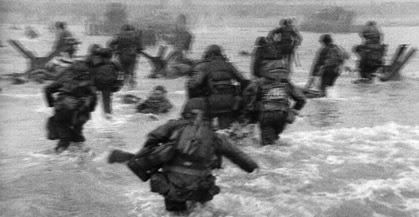
Every year, hundreds of thousands, mostly descendants of D-Day veterans, flood the key locations in Normandy where the future of Europe was decided. For many, especially Americans, it's the trip of a lifetime that they usually plan years ahead. For us, living in London, it's just two short train trips combined with the good fortune of having wonderful friends in Rouen who guide us in Normandy.

Paris
Since the fastest way to travel to Rouen is via Paris, a brief tour there doesn't hurt. Paris is very easy to move from place to place, both on foot and using the metro.
 Umberto Eco's fans used to flock Musée des Arts et Métiers to see Foucault's Pendulum. That was until a month ago, when it was irreparably damaged. The pendulum's cable snapped and its sphere crashed to the marble floor of the museum. So, now the best you can do is visit the Pantheon to see a more recent Foucault Pendulum. Notice the lack of "'s". Foucault's experiment in 1851 involved releasing the pendulum and watching the Earth rotate under its oscillation frame. It brought closure for Galileo and led the Church to accept the rotation of the Earth once and for all. More significantly than being the host of the pendulum, the Pantheon contains the remains of distinguished French citizens, including Voltaire, the Curies, Hugo, etc.
Umberto Eco's fans used to flock Musée des Arts et Métiers to see Foucault's Pendulum. That was until a month ago, when it was irreparably damaged. The pendulum's cable snapped and its sphere crashed to the marble floor of the museum. So, now the best you can do is visit the Pantheon to see a more recent Foucault Pendulum. Notice the lack of "'s". Foucault's experiment in 1851 involved releasing the pendulum and watching the Earth rotate under its oscillation frame. It brought closure for Galileo and led the Church to accept the rotation of the Earth once and for all. More significantly than being the host of the pendulum, the Pantheon contains the remains of distinguished French citizens, including Voltaire, the Curies, Hugo, etc.Next, Notre Dame,
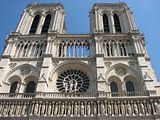 construction of which started in 1163 and finished in 1345. This now seems unbelievable, but at the time was almost normal. It was operational for most of this time, of course; just not complete.
construction of which started in 1163 and finished in 1345. This now seems unbelievable, but at the time was almost normal. It was operational for most of this time, of course; just not complete.No naval history buff arrives in Paris without visiting one of the oldest maritime museums in the world, la Musée National de la Marine.
 That day, it hosted a classical music concert in one of its rooms, which made it an extraordinary experience. Walking among priceless exhibits like Napoleon's own Imperial Barge while listening to live music written around his time. Sublime.
That day, it hosted a classical music concert in one of its rooms, which made it an extraordinary experience. Walking among priceless exhibits like Napoleon's own Imperial Barge while listening to live music written around his time. Sublime.More photos from the museum: A model of the aircraft carrier Bearn, a 16-inch shell from Battleship Richelieu or Jean Bart and a 19th century Whitehead torpedo.



For army history buffs, there is also the Musée de l'Armée, part of the splendid Les Invalides. In 1670, Louis the 14th decided to build a military hospital in Paris, to take care of disabled war veterans ("les invalides").
Today, the complex contains museums and monuments, all relating to the military history of France, as well as a hospital and a retirement home for disabled war veterans. Les Invalides is a masterpiece of French classical architecture. You will find there the tomb of Napoleon and other famous figures of French military history (e.g. Marshal Foch).
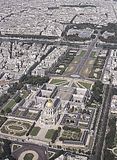

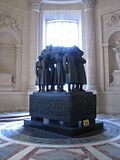
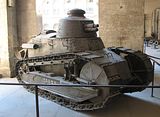 In terms of 20th century history, the Musée de l'Armée is not as impressive as it could be. I liked the rare FT-17 tank, but apart from this not much that you can't see elsewhere. Especially the World War II section could be much larger and much more informative.
In terms of 20th century history, the Musée de l'Armée is not as impressive as it could be. I liked the rare FT-17 tank, but apart from this not much that you can't see elsewhere. Especially the World War II section could be much larger and much more informative.Some more photos from Paris, including the Eiffel Tower, Sacre Coeur at Montmartre and a local market:
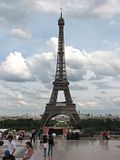
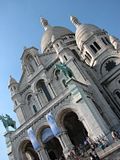
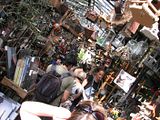
Rouen
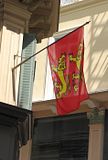 Next is the beautiful city of Rouen. In the Middle Ages, Rouen was one of the largest and most prosperous cities in the world. Originally founded by the Gauls, Rouen was later controlled by the Romans (remains of Roman structures can still be seen) and the Normans. In 912, Rouen became the capital of the Duchy of Normandy and residence of the dukes, until William the Conqueror established his castle at Caen. Even today, Caen and Rouen are still competing for the honour of being the capital of Normandy. At the moment it's Rouen.
Next is the beautiful city of Rouen. In the Middle Ages, Rouen was one of the largest and most prosperous cities in the world. Originally founded by the Gauls, Rouen was later controlled by the Romans (remains of Roman structures can still be seen) and the Normans. In 912, Rouen became the capital of the Duchy of Normandy and residence of the dukes, until William the Conqueror established his castle at Caen. Even today, Caen and Rouen are still competing for the honour of being the capital of Normandy. At the moment it's Rouen.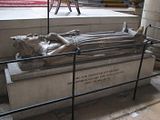
When I visited Rouen's Cathedral, I was surprised to find a tomb with the inscription: "HIC COR CONDITVM EST RICARDI ANGLORVM REGIS QVI COR LEONIS DICTVS OBIIT AN M C XC IX". The tomb contains the heart of Richard the Lionheart of England. He was after all the Duke of Normandy for quite a while.
In 1204, Philip II Augustus of France entered Rouen and annexed Normandy to the French Kingdom. Thanks to the river Seine, which connected Rouen to Paris, and the development of new industries, the city became more prosperous than ever before. During the Hundred Years' War, Rouen surrendered to Henry V of England, who returned Normandy to the Plantagenet dynasty.
 In 1431, Jean d' Arc was burned at the stake in Rouen, where most inhabitants supported the duke of Burgundy, Jean d' Arc's king enemy. She was only 19. In the 1920s, she was canonised and in the 1970s a very modern L’église sainte Jeanne d’Arc was built for her on the place where she was executed. It's one of the most modern-looking Catholic churchs you will ever see.
In 1431, Jean d' Arc was burned at the stake in Rouen, where most inhabitants supported the duke of Burgundy, Jean d' Arc's king enemy. She was only 19. In the 1920s, she was canonised and in the 1970s a very modern L’église sainte Jeanne d’Arc was built for her on the place where she was executed. It's one of the most modern-looking Catholic churchs you will ever see. On the same square, you will find our friend's restaurant, Les Maraichers. Make sure you taste the fries and if you are feeling brave, the veal head with Ravigote sauce. Les Maraichers is the third from the left. Belonging to the same family, the first from the left is La Couronne. That's the oldest restaurant in France (open since 1345). Sophia Lauren, John Wayne, Guderian and Rommel have all dined there.
On the same square, you will find our friend's restaurant, Les Maraichers. Make sure you taste the fries and if you are feeling brave, the veal head with Ravigote sauce. Les Maraichers is the third from the left. Belonging to the same family, the first from the left is La Couronne. That's the oldest restaurant in France (open since 1345). Sophia Lauren, John Wayne, Guderian and Rommel have all dined there.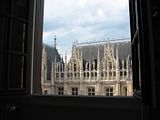
Rouen is one of the few places in the world where a cheap and cheerful 50 euro hotel offers that kind of view from your bed. That's the Palais de Justice as seen from the window of Le Bristol, where we stayed.
During the German occupation, the German Navy had its headquarters located in a chateau on what is now L' École Supérieure de Commerce de Rouen. The city was heavily damaged on D-day, but not as much as "rival" Caen, whose principal landmarks were razed to the ground. In Rouen, the battle was around the banks of the river instead of the city centre and most of the historic buildings survived:
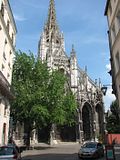
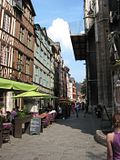


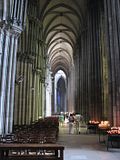
 The D-Day weekend was also the time of the Normandy Impressionists Festival. Thousands of visitors from all over the world and especially Japan, had arrived to Rouen for the numerous exhibitions and events. This is Monet's "The Seine at Rouen" from 1872.
The D-Day weekend was also the time of the Normandy Impressionists Festival. Thousands of visitors from all over the world and especially Japan, had arrived to Rouen for the numerous exhibitions and events. This is Monet's "The Seine at Rouen" from 1872.Next, D-Day.
Sainte-Mere-Eglise
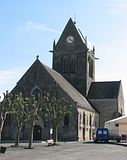 If you have watched "The Longest Day" (1962, John Wayne, Henry Fonda, Sean Connery, Richard Burton, ...), you know exactly why we started our D-Day tour from there. If you don't know why, take a look at these two photos.
If you have watched "The Longest Day" (1962, John Wayne, Henry Fonda, Sean Connery, Richard Burton, ...), you know exactly why we started our D-Day tour from there. If you don't know why, take a look at these two photos.During the early hours of D-Day, US airborne troops of the 82nd Airborne Division and a few scattered units of the 101st dropped around Sainte-Mere-Eglise. Their mission was to cut the main road to Cherbourg and open up the routes leading to Utah Beach. Due to heavy flak and winds, the drop was scattered,
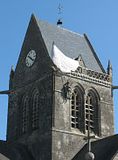 with many troops landing inside the village among civilians and German troops. The parachute of one of the paratroopers, John Steele, was caught on the spire of the town church. He hung there helpless for two hours, watching the fighting below and pretending to be dead, before the Germans took him prisoner. He later escaped from the Germans and rejoined his division when US troops attacked the village capturing thirty Germans and killing another eleven. Today, during the summer, a dummy hangs from the church tower to commemorate this battle.
with many troops landing inside the village among civilians and German troops. The parachute of one of the paratroopers, John Steele, was caught on the spire of the town church. He hung there helpless for two hours, watching the fighting below and pretending to be dead, before the Germans took him prisoner. He later escaped from the Germans and rejoined his division when US troops attacked the village capturing thirty Germans and killing another eleven. Today, during the summer, a dummy hangs from the church tower to commemorate this battle.Driving through Normandy, you see people dressed in world war 2 uniforms and immaculately preserved world war 2 vehicles everywhere. To give you an idea of how similar Normandy today is to the Normandy of the 1940s, we used a 1947 Michelin map to find our way.
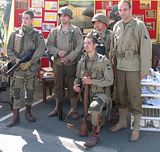
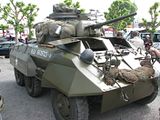
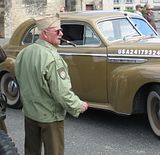
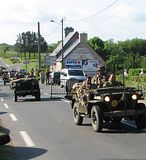
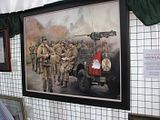
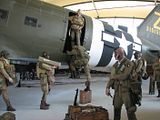
A most pleasant surprise was the demonstration of real Shermans rolling next to the
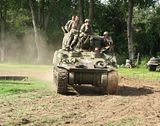 Airborne museum. That's one of the several surprises that await you in Normandy during the D-Day weekend. The whole of the region is an open-air museum. It's good to sketch out a general plan for the day, but you need to be flexible and expect to modify your plan often. A little bit like what the actual troops had to do in 1944. Oh well, that was a silly analogy. Anyway, here is the video that I recorded:
Airborne museum. That's one of the several surprises that await you in Normandy during the D-Day weekend. The whole of the region is an open-air museum. It's good to sketch out a general plan for the day, but you need to be flexible and expect to modify your plan often. A little bit like what the actual troops had to do in 1944. Oh well, that was a silly analogy. Anyway, here is the video that I recorded:Pointe du Hoc
Here is where the overwhelming for the senses part of the tour starts.
 In the history of warfare, few people have been given more daunting task than the U.S. 2nd Ranger Battalion on D-Day. They were ordered to capture the German guns pointing to both Omaha and Utah beach. The Rangers managed to climb the cliff under immense heavy fire and capture the position. However, the guns had already been moved by the Germans 1 mile away. Their commanders knew that, but the troops did not, so as not to question the necessity of the operation. Out of the 225 rangers, only 90 survived and could still fight.
In the history of warfare, few people have been given more daunting task than the U.S. 2nd Ranger Battalion on D-Day. They were ordered to capture the German guns pointing to both Omaha and Utah beach. The Rangers managed to climb the cliff under immense heavy fire and capture the position. However, the guns had already been moved by the Germans 1 mile away. Their commanders knew that, but the troops did not, so as not to question the necessity of the operation. Out of the 225 rangers, only 90 survived and could still fight.Many of the original fortifications have been left in place and the site is speckled with large bomb (and shell?) craters. In 1979, this field was ceded permanently from the French to the US government to be responsible for its maintenance.

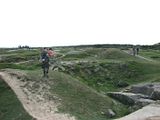
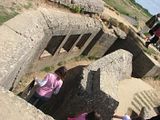
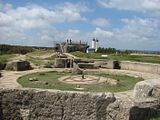
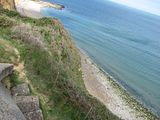
Next, we headed towards Omaha Beach. On the way we saw a camp with soldiers, a group of GIs that were lost and checking their map, and a Dakota flying in D-Day colours.

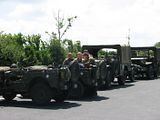

Omaha Beach

On D-Day, the untested 29th Infantry Division, nine companies of Rangers redirected from Pointe du Hoc, and the battle-hardened 1st Infantry Division were to assault Omaha Beach. The initial assault waves were carefully planned to reduce the coastal defenses and allow the larger ships of the follow-up waves to land.
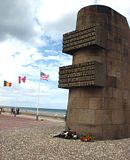 Very little went as planned during the landing. Difficulties in navigation caused the majority of landing craft to miss their targets throughout the day. The defences were unexpectedly strong, and inflicted heavy casualties on landing US troops. Small penetrations were eventually achieved by groups of survivors making improvised assaults, scaling the bluffs between the most heavily defended points. By the end of the day, two small isolated footholds had been won, which were subsequently exploited against weaker defences further inland, thus achieving the original D-Day objectives over the following days.
Very little went as planned during the landing. Difficulties in navigation caused the majority of landing craft to miss their targets throughout the day. The defences were unexpectedly strong, and inflicted heavy casualties on landing US troops. Small penetrations were eventually achieved by groups of survivors making improvised assaults, scaling the bluffs between the most heavily defended points. By the end of the day, two small isolated footholds had been won, which were subsequently exploited against weaker defences further inland, thus achieving the original D-Day objectives over the following days.Photos and videos don't capture the feeling of walking on Omaha Beach. You need to take your shoes off and walk on the sand, but in any case:
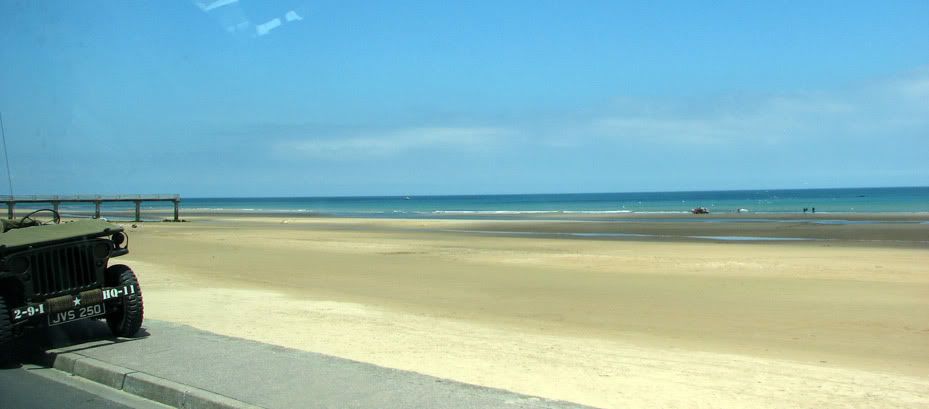
American Cemetery
 The Americans who died on Omaha beach are buried in the American Cemetery near Colleville-sur-Mer. Among them, three medals of honour; Jimmie W. Monteith, Frank D. Peregory and Theodore Roosevelt, Jr.
The Americans who died on Omaha beach are buried in the American Cemetery near Colleville-sur-Mer. Among them, three medals of honour; Jimmie W. Monteith, Frank D. Peregory and Theodore Roosevelt, Jr.J. Monteith's citation:
For conspicuous gallantry and intrepidity above and beyond the call of duty on 6 June 1944, near Colleville-sur-Mer, France. 1st Lt. Monteith landed with the initial assault waves on the coast of France under heavy enemy fire. Without regard to his own personal safety he continually moved up and down the beach reorganizing men for further assault. He then led the assault over a narrow protective ledge and across the flat, exposed terrain to the comparative safety of a cliff. Retracing his steps across the field to the beach, he moved over to where 2 tanks were buttoned up and blind under violent enemy artillery and machine gun fire. Completely exposed to the intense fire, 1st Lt. Monteith led the tanks on foot through a minefield and into firing positions. Under his direction several enemy positions were destroyed. He then rejoined his company and under his leadership his men captured an advantageous position on the hill. Supervising the defense of his newly won position against repeated vicious counterattacks, he continued to ignore his own personal safety, repeatedly crossing the 200 or 300 yards of open terrain under heavy fire to strengthen links in his defensive chain. When the enemy succeeded in completely surrounding 1st Lt. Monteith and his unit and while leading the fight out of the situation, 1st Lt. Monteith was killed by enemy fire. The courage, gallantry, and intrepid leadership displayed by 1st Lt. Monteith is worthy of emulation.
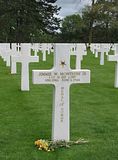

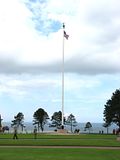
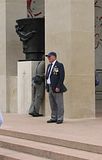

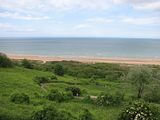
Arromanches
Before heading for Pegasus Bridge, we stopped briefly near Arromanches to take photos of the remains of the artificial floating harbour that protected the landings. These prefab concrete constructions were built in Britain and towed across the English Channel when the invasion began. According to our local guide, they rapidly sink year by year. He expects that they will not be visible in a few years.
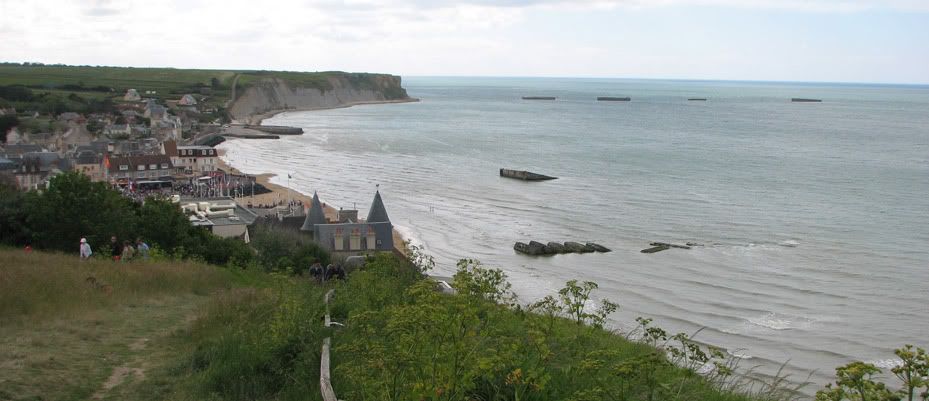

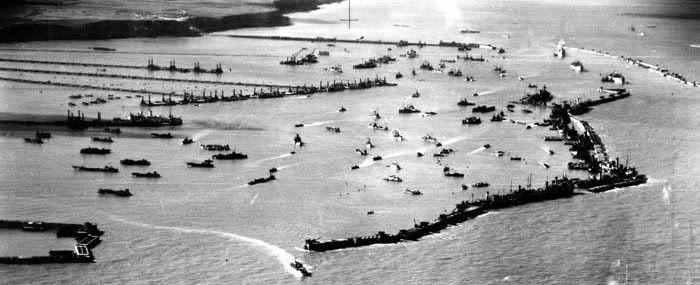
Pegasus Bridge
Last on our tour of Normandy was Pegasus Bridge.
On the night of 5 June 1944, a force of 181 British men took off from Dorset in six Horsa gliders to capture Pegasus Bridge. The object of this action was to prevent German armour from crossing the bridges and attacking the landings at Sword Beach. Five of the gliders landed as close as 47 yards from their objectives from 16 minutes past midnight. The attackers poured out of their battered gliders, completely surprising the German defenders, and took the bridges within 10 minutes. They lost two men in the process, Lieutenant Den Brotheridge and Lance-Corporal Fred Greenhalgh. Greenhalgh drowned when his glider landed. Lieutenant Brotheridge was killed crossing the bridge in the first minutes of the assault and became the first member of the invading Allied armies to die in combat on D-Day.
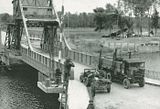 The bridge was captured by British glider troops in the first few minutes of D-day. The three Horsa gliders, visible in the top right brought Major John Howard and his troopers in on time, accurately placing them in position to seize the bridge by rapid surprise. Lt. Den Brotheridge, the first allied death on D-day was killed where the Jeep is standing as he and his men rushed across the bridge from the eastern side. Notice that the drivers, although in Europe, are still driving on the left side of the road.
The bridge was captured by British glider troops in the first few minutes of D-day. The three Horsa gliders, visible in the top right brought Major John Howard and his troopers in on time, accurately placing them in position to seize the bridge by rapid surprise. Lt. Den Brotheridge, the first allied death on D-day was killed where the Jeep is standing as he and his men rushed across the bridge from the eastern side. Notice that the drivers, although in Europe, are still driving on the left side of the road.The current bridge seen in the photo below is a larger replica built in 1994, as the original was not sufficient for today's widened canal. The original bridge was sold to the nearby Pegasus Memorial Museum for a symbolic one Franc.
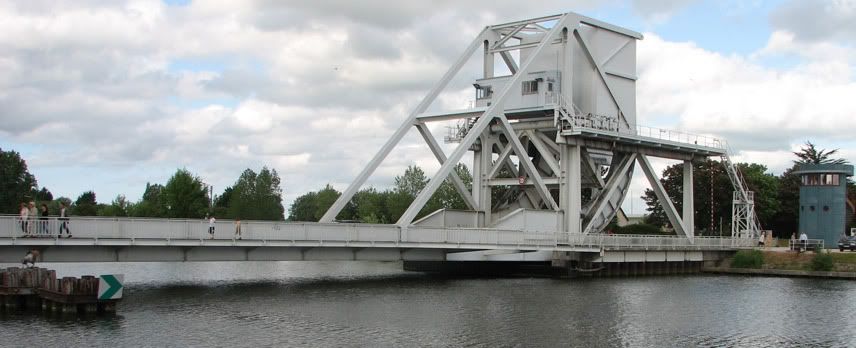
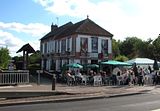 The house of the Gondrée family, next to the bridge, was the first to be liberated during D-Day. It still exists and today contains a café and a small museum shop that sells related memorabilia. Arlette Gondrée, who now runs Café Gondrée, was a little child living in the home when it was liberated.
The house of the Gondrée family, next to the bridge, was the first to be liberated during D-Day. It still exists and today contains a café and a small museum shop that sells related memorabilia. Arlette Gondrée, who now runs Café Gondrée, was a little child living in the home when it was liberated.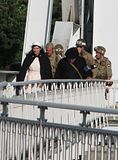
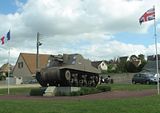
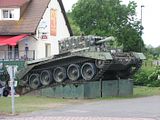
... and that's the end of our wonderful D-day trip.
I'll close with a video made by a fan of the Heavy Metal band Sabaton:
I love that model of the Bearn.
ReplyDelete